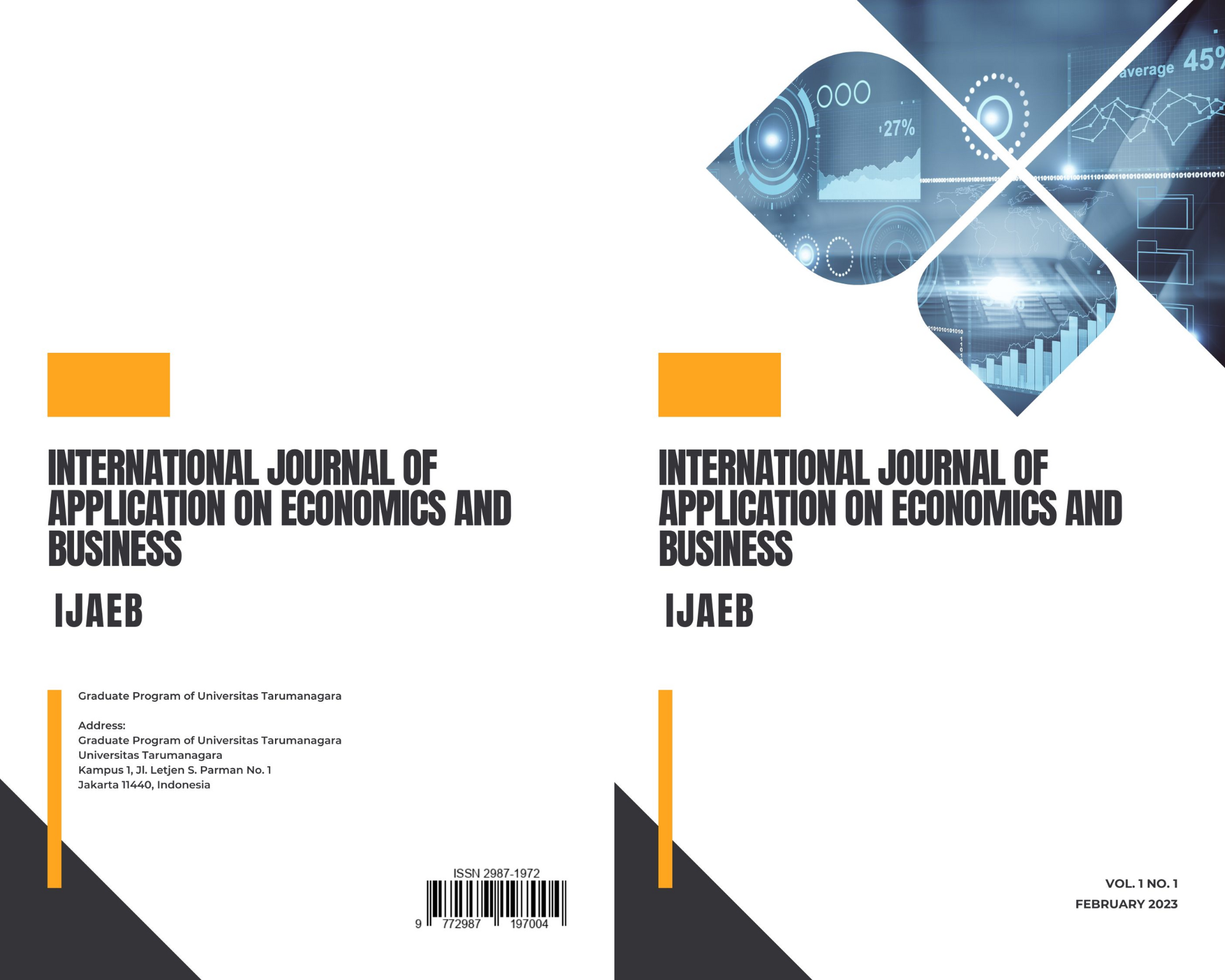Factors Influencing Stock Prices with Inflation as Moderating Variable
Main Article Content
Abstract
The purpose of this research is for specifying the impact of profitability ratio also solvency ratio on stock prices in manufacturing businesses registered under Indonesia Stock Exchange in 2018-2020 with inflation as moderating variable. The analysis used a method named, purposive sampling for the sample selection, and it was found that there were 72 samples of companies that could be used in the study. The data is processed with the help of the Microsoft Excel 2019 and EViews version 12 application program. The outcome from this research shows profitability ratio with the Return on Assets proxy, solvency ratio with the Debt-to-Equity Ratio proxy, and inflation have a positive also significant impact on the stock prices. Meanwhile, profitability ratio with Return on Equity proxy showed a negative as well as significant impact on the stock prices. Moreover, inflation is known to moderate the effect of profitability ratio for the Return on Assets proxy, profitability ratio for the Return on Equity proxy, and solvency ratio with Debt-to-Equity Ratio proxy to the stock prices.
Article Details

This work is licensed under a Creative Commons Attribution-NonCommercial-ShareAlike 4.0 International License.
This journal provides immediate open access to its content on the principle that making research freely available to the public supports a greater global exchange of knowledge.
IJAEB by Graduate Program of Universitas Tarumanagara is licensed under a Creative Commons Attribution-NonCommercial-ShareAlike 4.0 International License.. Permissions beyond the scope of this license may be available at https://journal.untar.ac.id/index.php/ijaeb
References
K. P. R. Indonesia, “Industri Manufaktur Terus Didorong untuk Perbanyak Terobosan,” 2019. https://kemenperin.go.id/artikel/20985/Industri-Manufaktur-Terus-Didorong-untuk-Perbanyak-Terobosan (Accessed in Oct. 31, 2021).
S. Widoatmodjo, Cara Cepat Memulai Investasi Saham Panduan bagi Pemula. Jakarta: Penerbit PT Elex Media Komputindo, 2012.
D. Indrajaya, D. Ramdhan, and L. Hakim, “The Influence of Profitability and Solvency Ratios on Stock Prices with Inflation as Moderating Variable (Case Study on BUMN),” Int. J. Technol. Bus., vol. 3, no. 2, pp. 73–86, 2019.
R. Osranek et al., Value Creation, Reporting, and Signaling for Human Capital and Human Assets. New York: Palgrave Macmillan, 2014.
E. Delbufalo, Springer Briefs in Business: Agency Theory and Sustainability in the Global Supply Chain. Cham: Springer International Publishing AG, 2018.
S. Jones et al., The Routledge Companion to Financial Accounting Theory. Oxon: Routledge, 2015.
M. M. Hanafi and A. Halim, Analisis Laporan Keuangan, 5th ed. Yogyakarta: UPP STIM YKPN, 2018.
M. Samonas, Financial Forecasting, Analysis, and Modelling: A Framework for Long-Term Forecasting. Chichester: John Wiley & Sons Ltd, 2015.
Yanuar, Ekonomi Makro: Suatu Analisis Konteks Indonesia, 3rd ed. Jakarta: Yayasan Mpu Ajar Artha, 2018.
C. O. Tumandung, S. Murni, and D. N. Baramuli, “Analisis Pengaruh Kinerja Keuangan terhadap Harga Saham pada Perusahaan Makanan dan Minuman yang Terdaftar di BEI Periode 2011 – 2015,” J. Ris. Ekon. Manajemen, Bisnis dan Akunt., vol. 5, no. 2, pp. 1728–1737, 2017.
T. Eldomiaty, Y. Saeed, R. Hammam, and S. AboulSoud, “The associations between stock prices, inflation rates, interest rates are still persistent: Empirical evidence from stock duration model,” J. Econ. Financ. Adm. Sci., vol. 25, no. 49, pp. 149–161, 2020, DOI: 10.1108/JEFAS-10-2018-0105.
H. Dalimunthe, “Pengaruh Marjin Laba Bersih, Pengembalian Atas Ekuitas, dan Inflasi Terhadap Harga Saham,” J. Akunt. dan Bisnis, vol. 4, no. 2, pp. 62–70, 2018, DOI: http://dx.doi.org/ 10.31289/jab.v4i2.1780.
N. M. R. Noviyah, “Pengaruh Profitabilitas, Likuiditas, Dan Solvabilitas Terhadap Harga Saham Perbankan Dengan Inflasi Sebagai Variabel Moderating Pada Periode 2007-2015,” J. Manaj. Bisnis Indones., vol. 5, no. 2, pp. 133–148, 2018, DOI: 10.31843/jmbi.v5i2.159.
A. Kundiman and L. Hakim, “Pengaruh Current Ratio, Debt To Equity Ratio, Return on Asset, Return on Equity Terhadap Harga Saham Pada Indeks LQ 45 Di BEI Periode 2010-2014,” Among Makarti, vol. 9, no. 2, pp. 80–98, 2016, DOI: 10.52353/ama.v9i2.140.
T. Akbar and A. Afiezan, “Determinasi Harga Saham Syariah Melalui Analisis Terhadap Faktor Fundamental dan Makro Ekonomi,” J. Ilm. Wahana Akunt., vol. 13, no. 1, pp. 1–12, 2018, DOI: doi.org/10.21009/wahana-akuntansi/13.011.
Efrizon, “Pengaruh Rasio Keuangan Terhadap Harga Saham Perusahaan Otomotif Periode 2013-2017,” J. Akunt. Aktual, vol. 6, no. 1, pp. 250–260, 2019, DOI: 10.37303/embeji.v5i1.72.
R. Widayanti and F. Colline, “Pengaruh Rasio Keuangan terhadap Harga Saham Perusahaan LQ 45 Periode 2011 - 2015,” Bina Ekon., vol. 21, no. 1, pp. 35–49, 2017, DOI: 10.26593/ be.v21i1.2622.35-49.
A. D. I. R. Dewi and L. G. S. Artini, “Pengaruh Suku Bunga SBI, Inflasi, dan Fundamenal Perusahaan Terhadap Harga Saham Indeks LQ-45 di BEI,” E-Jurnal Manaj. Univ. Udayana, vol. 5, no. 4, pp. 2484–2510, 2016.
Y. Rachmawati, “Pengaruh Inflasi dan Suku Bunga Terhadap Harga Saham Pada Perusahaan Perbankan yang Terdaftar di LQ45 Bursa Efek Indonesia,” J. Media Akunt., vol. 1, no. 1, pp. 66–79, 2018.
N. L. C. Silva, “Effect Of Inflation On Stock Prices: Evidence From Sri -Lanka,” Int. J. Sci. Eng. Res., vol. 7, no. 4, pp. 1278–1279, 2016.
M. Fahlevi, “The Influence of Exchange Rate, Interest Rate and Inflation on Stock Price of LQ45 Index in Indonesia,” Atl. Press, vol. 343, pp. 157–163, 2019, DOI: 10.2991/icas-19.2019.34.



